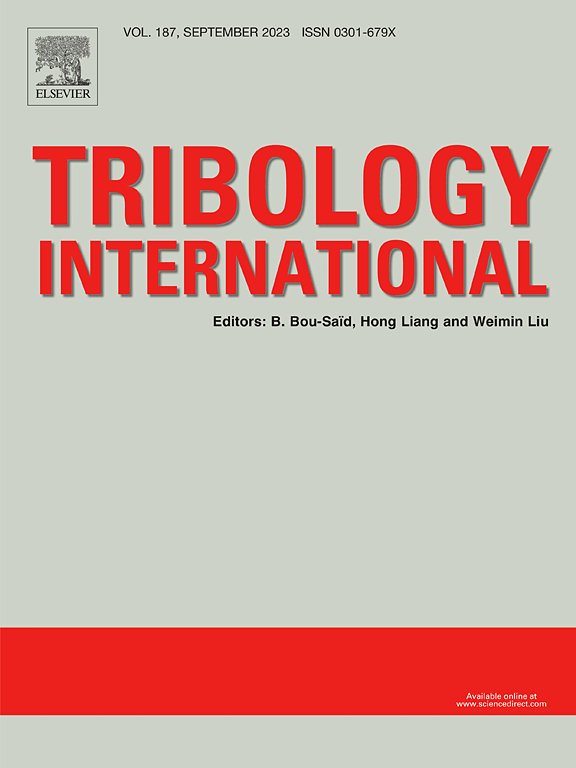氮合金 MoSe2 涂层--优化形态、结构和机械性能对不同环境下滑动性能的影响
IF 6.1
1区 工程技术
Q1 ENGINEERING, MECHANICAL
引用次数: 0
摘要
过渡金属二硫化物(TMD)涂层作为减少摩擦、提高节能和降低碳足迹的环保解决方案,正日益受到科学界的关注。n合金MoSe2涂层(MoSeN)是TMDs的一个分支,目前尚未得到充分开发,尚未对其在各种滑动环境下的摩擦性能进行研究。本文对含氮量为0 ~ 42 %的直流磁控溅射MoSeN涂层进行了深入分析。研究了其组成、形态特征、晶体结构、机械强度和滑动性能。我们的研究结果表明,N的添加增加了致密性,无定形结构和~ 4.6 GPa的硬度,尽管成分不同,这些改进仍然保持一致。在六种不同的条件下对滑动能力进行了评估,在室温和100°C的环境空气和干n2气氛下显示了令人满意的结果。在200°C时,环境空气中的滑动性能优于干n2。n合金涂层的摩擦系数相对较近,在0.03 ~ 0.06之间,除了200°C的干n2环境。然而,磨损率表现出轻微的变化,在100°C和200°C的干n2中观察到较高的值,但在所有其他条件下保持在1-7 × 10−7 mm3/Nm的特定范围内。这项研究强调了MoSeN涂层在工业应用中的潜力,为减少PVD溅射的固有限制提供了路线图。本文章由计算机程序翻译,如有差异,请以英文原文为准。
Nitrogen alloyed MoSe2 coatings – Role of optimized morphology, structure and mechanical properties on diverse environment sliding performance
Transition metal dichalcogenide (TMD) coatings are gaining increasing interest among the scientific community as eco-friendly solutions for reducing friction, improving energy conservation, and lowering carbon footprints. N-alloyed MoSe2 coatings (MoSeN), a subset of TMDs, remain largely underexplored, with no research on their frictional performance across various sliding environments. Herein, an in-depth analysis of DC-magnetron sputtered MoSeN coatings is presented, with N content varying from 0 to 42 at%. Investigation of composition, morphological features, crystal structure, mechanical strength and sliding performance are accessed. Our findings revealed that N additions resulted in increased compactness, amorphous structure and hardness of ∼4.6 GPa, and these improvements remained consistent despite compositional variations. The sliding competency was evaluated under six different conditions, revealing promising results in ambient-air and dry-N2 atmospheres at room conditions and 100 °C. At 200 °C, the sliding performance in ambient-air was better than dry-N2. Friction coefficient for N-alloyed coatings was relatively close, ranging between 0.03 and 0.06, except for a dry-N2 environment at 200 °C. Nevertheless, wear rate showed slight variations, with higher values observed in dry-N2 at 100 °C and 200 °C but remained within a specific range of 1–7 × 10−7 mm3/Nm for all other conditions. This study highlights the potential of MoSeN coatings to be scaled for industrial applications, offering a roadmap for reducing the inherent limitations of PVD sputtering.
求助全文
通过发布文献求助,成功后即可免费获取论文全文。
去求助
来源期刊

Tribology International
工程技术-工程:机械
CiteScore
10.10
自引率
16.10%
发文量
627
审稿时长
35 days
期刊介绍:
Tribology is the science of rubbing surfaces and contributes to every facet of our everyday life, from live cell friction to engine lubrication and seismology. As such tribology is truly multidisciplinary and this extraordinary breadth of scientific interest is reflected in the scope of Tribology International.
Tribology International seeks to publish original research papers of the highest scientific quality to provide an archival resource for scientists from all backgrounds. Written contributions are invited reporting experimental and modelling studies both in established areas of tribology and emerging fields. Scientific topics include the physics or chemistry of tribo-surfaces, bio-tribology, surface engineering and materials, contact mechanics, nano-tribology, lubricants and hydrodynamic lubrication.
 求助内容:
求助内容: 应助结果提醒方式:
应助结果提醒方式:


